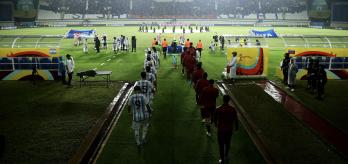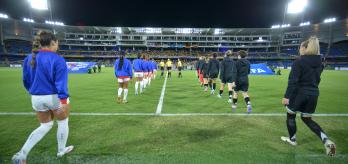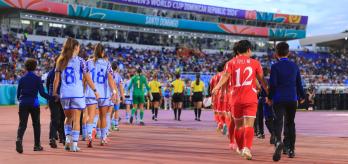Key take-aways
- The Relative Age Effect concept was present, with players born in the first quarter of the year (January, February, March) being over-represented (28.4%) in squads in comparison to 22.8% in the final quarter (October, November, December).
-
Over three-quarters of the players who participated in the tournament play for top-division clubs (77.4%), including Spain, Colombia, Korea DPR and the Netherlands who all recorded 100%, while Japan had 0% as all players are affiliated with a high school or university and play outside of the professional system.
-
78.3% of all participants earned youth national team caps between U-16 and U-19 level with percentages ranging from 100% for Austria, Brazil, France and New Zealand to 47.6% for Australia.
Introduction
This article is the result of a joint research project conducted by FIFA High Performance and the CIES Football Observatory research group. The composition of the national teams that qualified for the FIFA U-20 Women’s World Cup Colombia 2024 is analysed in this study. To this end, we conducted an analysis of the birth dates of the 504 players selected, their teams and leagues of employment, as well as their potential selections in younger age categories (national teams from U-16 to U-19).
The 24 qualified associations represented all confederations, with a maximum of five for UEFA and CONMEBOL and a minimum of two for the OFC. The AFC, CAF, and Concacaf are represented by four teams each. Four associations participated in a U-20 World Cup final tournament for the first time (Austria, Cameroon, Fiji, and Morocco), while five participating nations previously secured the championship title, namely Germany and the USA (on three occasions), Korea DPR (two), and Japan and Spain (one).
What year were players born?
An analysis of the dates of birth of the selected players allows for an understanding of their distribution by year and month of birth. In terms of year of birth, players born in 2004 represented the largest class with 38.3%, with the remaining 61.7% of players born in later years. Among the thirteen players born in 2008, Fiji goalkeeper Aliana Vakaloloma was the youngest (aged 15.9 years).
The analysis by month of birth allows for the testing of the Relative Age Effect (RAE). This concept refers to the typical over-representation of players born in the months immediately preceding the selected limit for defining an age category. In this case, the selection cut-off date is January. These players are generally at a competitive advantage due to their more advanced age as well as physical and psychosocial development compared to players born later in the year.
When the twelve months were divided into four birth quartiles, overall, there was a small effect across the sample, with 28.4% of players born in the initial quarter of the year (i.e., January, February, and March), compared to 24.0% in the second quarter, 24.8% in the third quarter, and 22.8% in the final quarter (i.e. October, November, and December). However, when the data was observed at the confederation level, there was a clear over-representation of players born in the first quarter of the year in the OFC (33.3%), the AFC (31.0%), UEFA (30.5%), and Concacaf (29.8%). Similarly, CONMEBOL had an over-representation in the second quarter (31.4%), whilst, interestingly, CAF were the only confederation to have an over-representation in the fourth quarter (31.0%). With CAF removed from the dataset, 29.5% of players were born in the first quarter of the year against 21.2% in the last.
Leagues And Clubs Of Employment
Over 75% of those selected for the FIFA U-20 Women’s World Cup play for top-level clubs. This percentage is particularly high in UEFA (90.5%) and CONMEBOL (84.8%) where top clubs readily integrate the best young talent into their ranks. The relatively low percentage in the AFC (69.0%) and Concacaf (56.0%) is due to the importance of high school and universities in the development of young talent.
All of the players selected by the Netherlands, Spain, Colombia, and Korea DPR are currently playing for clubs in the top division. For the first two, this illustrates the effectiveness of the First League in retaining the country's top-performing athletes. In Korea DPR, the state system fosters the development of players within a state-sponsored competition, wherein all participants are employed. Of the 24 associations included in the study, 17 had more than 80% of their players competing at the top level.
The low values at the bottom of the ranking can be attributed to the fact that the development of young players is not overseen by the professional teams, but rather by the education or private training systems of the respective associations. In Korea Republic, all players are affiliated with a high school or university, where they participate in competitions outside of the professional system. This phenomenon is also observed to a lesser extent in the US States Soccer Federation and the Canadian Soccer Association, where the majority of players are enrolled in American universities. It is important to highlight that, at these universities, players are likely to receive salaries and/or scholarships equivalent to the professional leagues around the world for women’s football.
Regarding the proportion of footballers competing for clubs affiliated with the association in question, 77.8% of participants at the FIFA U-20 Women’s World Cup Colombia 2024 were included in this category. The highest percentage was observed in the AFC (94.0%), while the lowest was noted for CAF selections (61.9%). This outcome can be attributed to two factors: (1) the inclination of African players to pursue opportunities abroad at an early age, and (2) the selection of footballers born outside their country of origin. Notably, Morocco employed the latter strategy as 15 players born outside the country participated in the tournament (see Figure 6.2).
Canada represented a unique case, with all the players being employed in the USA (with the exception of one in England). Additionally, the USA's university and professional teams have a significant impact on the recruitment of players from the Americas.
PARTICIPATION IN PREVIOUS YOUTH NATIONAL TEAMS’ AGE CATEGORIES
The transition of players between the different age categories of the youth national teams is also an issue of particular interest. In many associations where training at club and academy level is not yet at the level of the most developed countries, the national youth team channel is potentially of particular importance in allowing the best talents to develop their full potential. Only 20 of the 24 qualified associations could provide reliable statistics on the eventual matches played by their footballers called up for the FIFA U-20 Women’s World Cup 2024.
The highest percentage (100%) was recorded for four associations from three different confederations: Austria, Brazil, France, and New Zealand. These associations demonstrated an ability to capitalise on a generation of players with significant potential, developing a particularly successful squad over time. In New Zealand, for instance, all the female players participated in the U-17 Women’s World Cup India 2022. This may be attributed to the fact that there is no clear pathway for women in New Zealand (i.e. no professional league). In other words, a lack of competition and resources amounts to the same players being selected. Likewise, most of the French players participated in the U-19 Women's EURO finals held in Lithuania in 2024 and have experience in each of the U-16 to U-19 selections, who have a more developed infrastructure and player pathway for women’s football. It is therefore important to understand that each member association will be constrained by their own competition structures and development pathways. It is also essential that a regular international calendar exists in all confederations, enabling young girls to capitalise on their experience.
Conclusion
Most of the players that participated at the FIFA U-20 Women’s World Cup Colombia 2024, representing 78.0% of the total, played for top-division clubs. The percentages range from 100% for Colombia, Korea DPR, the Netherlands, and Spain to zero for the case of Korea Republic. These discrepancies can be attributed to the disparate structures that organise training and elite soccer in the respective associations. In Europe and South America, professional clubs integrate young players, whereas in North America and Northeast Asia, this process is delegated to the education system. In Africa, although still developing, the existence of women's championships at the association level ensures that players have access to high-level training opportunities.
77.8% of the selected players were affiliated with a club within the same national association. However, the situation varies considerably between associations, with a clear distinction between those where the majority of female footballers were based locally and those where they were not. In the former case, expatriate players are recruited as part of an international transfer market. For example, Shana Chossenotte was transferred from Stade de Reims Féminines in Division 1 Féminine to Leicester City in the English Women's Super League during July 2024. The second case is exemplified by Morocco, where a total of 15 players were born outside the country and are therefore exercising their talents in the associations with which they grew up.
The RAE is observed among the sample, with 29.2% of players born in the first quarter of the year when CAF is removed. While the values are less sensitive than in other competitions (e.g., recent data from the Men's U-20 World Cup), the figures indicate a trend that favours women born at the beginning of the year. It is important to note that there are developments that could make the RAE more important, such as greater competition between young girls for places in the national squads as well as greater attention paid to physical aspects in the preparation of players. Coaches and trainers must pay particular interest to the RAE so that the best potential players can express their talent at the highest level and gain experience without selection bias.





















